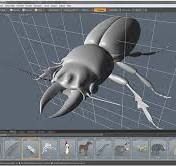The Power of 3D Design Software
3D design software has revolutionized the way designers, engineers, architects, and artists create and visualize their ideas. With the ability to generate three-dimensional models with intricate details and realistic textures, 3D design software has become an essential tool in various industries.
One of the key advantages of 3D design software is its ability to provide a more immersive and interactive design experience. Designers can manipulate objects in a virtual space, rotate them from different angles, and simulate real-world interactions. This level of realism allows for better visualization of the final product and helps identify potential issues early in the design process.
Another benefit of 3D design software is its versatility. Whether you are designing a product prototype, creating architectural blueprints, developing visual effects for movies, or crafting intricate artworks, 3D design software offers a wide range of tools and features to bring your vision to life.
Furthermore, 3D design software enables collaboration among team members located in different locations. With cloud-based platforms and real-time editing capabilities, designers can work together on a project simultaneously, share feedback instantly, and streamline the design workflow.
As technology continues to advance, 3D design software is constantly evolving to meet the demands of modern creators. New features such as virtual reality integration, parametric modeling, and artificial intelligence tools are pushing the boundaries of what is possible in the world of 3D design.
In conclusion, 3D design software has transformed the way we conceptualize and create designs across various industries. Its ability to provide realistic visualizations, enhance collaboration, and adapt to emerging technologies makes it an indispensable tool for anyone looking to unleash their creativity in a three-dimensional space.
5 Essential Tips to Enhance Your 3D Design Software Skills
- Practice using keyboard shortcuts to speed up your workflow.
- Take advantage of online tutorials and resources to improve your skills.
- Experiment with different tools and features to discover new techniques.
- Organize your workspace for efficiency and easier navigation.
- Regularly save your work to prevent losing progress.
Practice using keyboard shortcuts to speed up your workflow.
Utilizing keyboard shortcuts is a valuable tip to enhance your efficiency when working with 3D design software. By mastering and incorporating keyboard shortcuts into your workflow, you can significantly reduce the time spent on repetitive tasks and navigate through the software more swiftly. This practice not only boosts your productivity but also allows you to focus more on the creative aspects of your design process. Embracing keyboard shortcuts as a regular part of your routine can help streamline your work and make you a more proficient user of 3D design software.
Take advantage of online tutorials and resources to improve your skills.
Taking advantage of online tutorials and resources is a valuable tip for enhancing your skills in 3D design software. With a vast array of instructional videos, articles, forums, and courses available online, aspiring designers can access valuable insights, tips, and step-by-step guidance to master the intricacies of 3D design tools. By dedicating time to learning from these resources, designers can expand their knowledge, explore new techniques, and stay up-to-date with the latest trends in the ever-evolving world of 3D design. Continuous learning through online tutorials can significantly boost creativity and proficiency in utilizing 3D design software effectively.
Experiment with different tools and features to discover new techniques.
To enhance your skills in 3D design software, it is beneficial to experiment with various tools and features to uncover new techniques. By exploring different functionalities within the software, you can expand your creative repertoire and discover innovative ways to bring your ideas to life. Embracing a spirit of experimentation not only fosters growth and proficiency but also encourages a deeper understanding of the software’s capabilities, enabling you to push the boundaries of your designs and achieve unique outcomes.
Organize your workspace for efficiency and easier navigation.
Organizing your workspace is a crucial tip for maximizing efficiency and streamlining navigation when working with 3D design software. By arranging tools, panels, and assets in a logical manner, you can save time searching for essential components and focus more on the creative process. A well-organized workspace not only enhances productivity but also reduces distractions, allowing you to stay in the flow and bring your design ideas to life seamlessly. Whether it’s grouping similar tools together, customizing shortcuts for quick access, or decluttering unnecessary elements, taking the time to optimize your workspace layout can greatly improve your overall workflow in 3D design software.
Regularly save your work to prevent losing progress.
Regularly saving your work is a crucial tip when using 3D design software to prevent the loss of valuable progress. By saving your project frequently, you ensure that any unexpected crashes or technical issues do not result in hours of work being lost. It is best practice to establish a habit of saving your work at key milestones or after making significant changes to your design. This simple yet effective precaution can save you time and frustration, allowing you to focus on unleashing your creativity without the fear of setbacks.
Tags: 3d design software, architects, artificial intelligence tools, artists, cloud-based platforms, collaboration, courses, designers, efficiency, engineers, forums, immersive experience, instructional videos, interactive design, keyboard shortcuts, online tutorials, parametric modeling, realism, resources, skills improvement, techniques discovery, virtual reality integration, visualization, workflow enhancement
